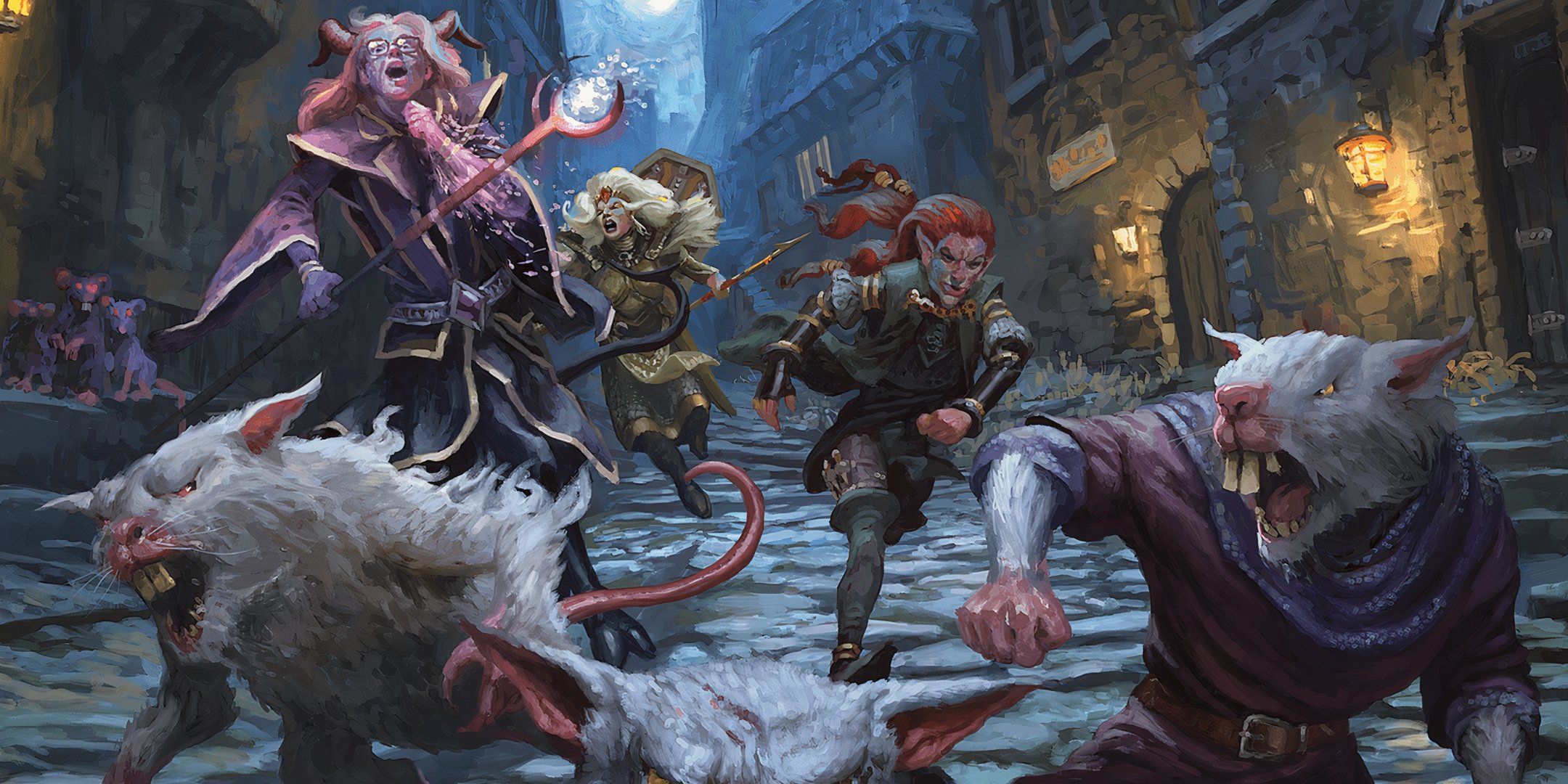Combat is one of the most electrifying parts of any Dungeons & Dragons session. But what’s a DM to do when your players are getting bored with the same types of combat encounters? Hack-and-slashing your way through monsters for XP is great, but sometimes, it’s best to shake things up.

Related
What Tips Would You Give A New Player To Dungeons & Dragons?
My advice? Don’t worry too much about the rules; just have fun and learn as you go. The DM will let you know if there’s something you can’t do – or, more likely, they’ll work with you to find a way within the rules for you to pull it off.
Experienced players, comment below with your best tips for newbies!
The best way to do this is to create unconventional combat objectives. When combat starts, players tend to expect that the way they end the encounter is by killing the enemy. But, you can keep things fresh by changing the overall goal of the encounter, forcing players to rely on different skills and think on their feet. Here’s everything you need to know to create unconventional combat objectives in your sessions.
How To Discourage Wanton Violence
The first thing you need to do as a DM to create a different kind of goal for your party to achieve is to take violence off the table as a solution. By default, killing or defeating enemies in combat is the standard solution for encounters in D&D. If you can get this idea out of your head, you’ll be in better shape from the start.
The next thing to consider is alternative goals for your party to achieve. Unconventional goals can take on many forms, and while they may involve combat, they should change the types of tactics your players use. Here are just a few examples:
- Retrieving an item or magical artifact.
- Saving a trapped NPC or ally.
- Shutting down a powerful arcane machine.
- Preventing a ritual from taking place.
- Stealing plans, documents, or schematics.
You can use one of the above examples as an unexpected combat goal, or you can homebrew your own! Ultimately, the core idea is to find ways to get players to use their other abilities that aren’t just attacks.
How To Connect The Goal To The Story
Whatever non-violent goal you come up with for your combat encounter, it’s best if you tie this idea into the larger narrative arc you’re weaving for your players. Threading in the main quest your players are journeying on is always helpful, but particularly great for combat encounters.
If you are planning on using a Campaign Journal, consider consulting your Campaign Conflicts sheet and making sure that each combat encounter you run connects narratively to at least one overarching conflict. Sample Campaign Conflicts sheets can be found in Chapter Five of the 2024 Dungeon Master’s Guide.
For example, a great alternative combat goal can be “remove a magic item from the enemy’s person.” But, if that item is just some random object the party’s never heard of, this goal doesn’t carry much weight. Consider how you can take some of our sample combat objectives and tie them into your narrative like so:
|
Objective |
Narrative Tie-In |
|---|---|
|
Retrieving A Magical Item |
The magical item the party must retrieve is the long-lost heirloom of one of the character’s families. Taking this item back and returning it to their homeland is of emotional significance to the character and their family. |
|
Saving A Trapped NPC |
The trapped NPC in question is the kindly wizard who first introduced the party in their very first session. The party has a great affinity for this character and would risk life and limb for them. |
|
Shutting Down An Arcane Machine |
The party’s main antagonist stole the designs and technology developed by one of the party members, an artificer and tinkerer. The party refuses to let their fellow adventurer’s invention wreak havoc on the world. |
|
Preventing A Ritual From Taking Place |
A maligned cult is preparing a ritual that will spread a magical contagion over the farmlands of the party’s home kingdom. If they fail to stop the ritual, the party’s friends and family risk starvation. |
|
Stealing Plans, Documents, or Schematics |
The party has heard that a key antagonist in their quest holds a recipe for brewing a potion that can mimic the effects of Greater Restoration. Retrieving this recipe is the only way to save the life of a cursed ally of the party, who has been blighted with a powerful and lethal curse. |
How To Surprise Your Players
The element of surprise is always a DM’s best friend. Now that you’ve constructed your alternative combat objective, and have found a way to tie this objective into the larger narrative at play, what’s the best way to introduce this idea to your players? Coming right out at the top of the encounter and explaining what the unconventional objective is can feel a bit dry.
The phrase “show, don’t tell” is one that DM’s should always keep in the back of their minds. Not telling the party what to do when showing them what to do will always feel more rewarding than the alternative!
When running unconventional combat encounters, consider how to clue your players into the alternative nature of this fight with different signals and hints. While the combat encounter can start normally, you should surprise your players with the reveal of the unconventional goal midway through the encounter. Now, let’s add to our sample encounter goal table.
|
Objective |
Narrative Tie-In |
Surprise |
|---|---|---|
|
Retrieving A Magical Item |
The magical item the party must retrieve is the long-lost heirloom of one of the character’s families. Taking this item back and returning it to their homeland is of emotional significance to the character and their family. |
If the player in question gets into melee range of the magical item, have them roll a perception check. If they roll above a certain DC, tell them that they recognize the item hanging off their assailant’s person. |
|
Saving A Trapped NPC |
The trapped NPC in question is the kindly wizard who first introduced the party in their very first session. The party has a great affinity for this character and would risk life and limb for them. |
After a few rounds of combat, have this wizard NPC cast Message, alerting the party that they are trapped in a prison cell beneath the floorboards and need help! |
|
Shutting Down An Arcane Machine |
The party’s main antagonist stole the designs and technology developed by one of the party members, an artificer and tinkerer. The party refuses to let their fellow adventurer’s invention wreak havoc on the world. |
After combat begins, have an enemy combatant switch on the Arcane Machine. The room can illuminate brightly, revealing the familiar nature of the machine to the party. |
|
Preventing A Ritual From Taking Place |
A maligned cult is preparing a ritual that will spread a magical contagion over the farmlands of the party’s home kingdom. If they fail to stop the ritual, the party’s friends and family risk starvation. |
During combat, party members close enough to the ritualistic circle can be asked to make Wisdom saves. Those who fail may begin to see visions of their homeland swarmed by locusts and plague. |
|
Stealing Plans, Documents, or Schematics |
The party has heard that a key antagonist in their quest holds a recipe for brewing a potion that can mimic the effects of Greater Restoration. Retrieving this recipe is the only way to save the life of a cursed ally of the party, who has been blighted with a powerful and lethal curse. |
While the party knows that the potion recipe lies in their antagonist’s lair, they don’t know where. Forcing players to spend their action looking for the recipe in a crammed bookshelf will turn the encounter on its head. |
Why Twists And Stakes Matter
So, now you have your unconventional objective, your tie-in to the narrative, and the element of surprise on your side. The last step in creating a memorable and unconventional combat encounter is to integrate twists and stakes into rounds of combat.
Including restrictions, twists, and stakes like time limits or other consequences is imperative to unconventional combat goals. If the unconventional goal can be achieved by just hacking and slashing your way through the encounter, the encounter will feel stale again.
This can include things like time limits, eternally resurrecting enemies, lair actions, environmental effects, the incursion of new monsters, and more. So, all-in-all, when you’ve tied everything together, your encounter should look like this.
- Select An Unconventional Objective – Whatever you choose, avoid violence as a solution, and force players to think creatively.
- Tie This Objective In Narratively – After you’ve selected a goal, make sure to tie this idea into either a player character’s backstory or the party’s larger goals.
- Surprise The Party – Reveal the surprising nature of this goal midway through a combat encounter, turning the tables suddenly.
- Twists & Stakes – Incorporate time limits, restrictions, lair actions, or other effects midway through fights, keeping obstacles constantly in the party’s path.
Now, you’re ready to create completely unexpected combat objectives that’ll keep even your most seasoned players on their toes. In addition, as a DM, you’ll find running these types of encounters more fun to run as you can focus more on narrative and dramatic flare as opposed to just stats and hit points.

Next
Dungeons & Dragons: How To Manage Time
The theatre of the mind runs at many speeds.
Source link
















Leave a Reply